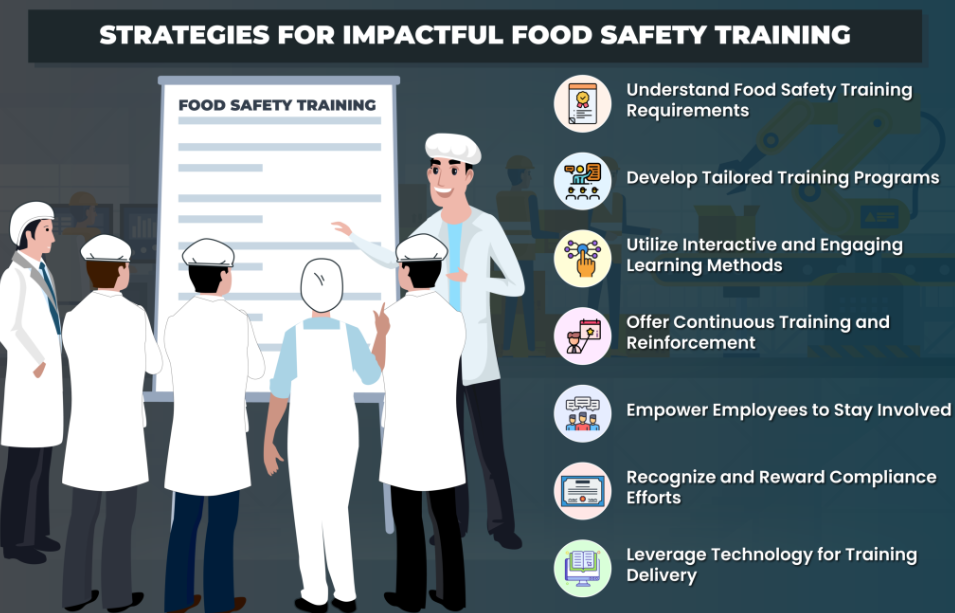
When it comes to restaurant dining, 94% of consumers have confidence that the food prepared is safe, and 98% say all employees in a restaurant should be properly trained in food safety, as per a national online survey of 1,010 adults conducted on May 2023, by the National Restaurant Association. These statistics illustrate the strong connection between the consumer mindset of safe food and the importance of food safety training for employees. One of the most critical aspects of maintaining food safety is having in place effective training protocols.
Several facets need to go hand-in-hand and be employed under food safety training efforts to yield optimal food safety outcomes. To achieve success in food safety training, several key components must be considered:
Regulatory Compliance – Training programs should cover relevant food safety regulations and standards applicable to the specific industry and jurisdiction. This ensures that employees understand their legal obligations and can work towards compliance effectively.
Hazard Analysis and Critical Control Points (HACCP) – Employees should understand the principles of HACCP and how to implement them to prevent food safety hazards.
Personal Hygiene Practices – Training should cover practices such as handwashing, proper attire, and avoiding cross-contamination to maintain personal hygiene standards.
Safe Food Handling Procedures – Employees should be trained in safe food handling practices, including storage, thawing, cooking, cooling, and reheating.
Allergen Management – Training should address the identification and handling of allergenic ingredients to prevent cross-contact and allergic reactions.
Cleaning and Sanitization – Training should cover proper cleaning procedures, the use of cleaning agents, and the frequency of sanitization.
Temperature Control – Training should cover temperature monitoring, calibration of equipment, and proper storage practices to maintain food safety.
Food Safety Culture – Training should emphasize the importance of individual accountability, teamwork, and continuous improvement in food safety practices.
A successful food safety training strategy must prioritize thorough education, ongoing reinforcement, and practical application. The following are the points to keep in mind:
Understanding Food Safety Regulations and Standards
Whether it’s the FDA’s Food Code, HACCP principles, or industry-specific requirements, compliance is non-negotiable. Training materials should be aligned with these regulations to ensure that employees are equipped to meet legal obligations.
Tailoring Training Programs to Job Roles
One size does not fit all when it comes to food safety training. Different job roles within a food establishment have varying responsibilities and risks. Tailoring training programs to specific job functions ensures that employees receive relevant and practical information. For example, kitchen staff may require training on proper food handling and hygiene practices, while managers may need instruction on regulatory compliance and crisis management.
Utilizing Interactive and Engaging Learning Methods
Traditional lecture-style training sessions can be dull and ineffective. To maximize engagement and retention, incorporate interactive and engaging learning methods into training programs. This can include hands-on demonstrations, role-playing exercises, interactive quizzes, and multimedia presentations. By making training sessions interactive and participatory, employees are more likely to retain key information and apply it in their daily work.
Offering Continuous Training and Reinforcement
Food safety training is not a one-time event; it’s an ongoing process. Regular reinforcement of key concepts is essential for maintaining a culture of food safety within an organization. Offer refresher courses, toolbox talks, and regular updates to ensure that employees stay up-to-date with the latest practices and regulations. Continuous training reinforces the importance of food safety and helps prevent complacency over time.
Empowering Employees to Speak Up
Encourage a culture of open communication and empowerment where employees feel comfortable speaking up about food safety concerns. Provide avenues for reporting issues, such as anonymous hotlines or suggestion boxes. Empowering employees to voice their concerns helps identify potential hazards early and fosters a proactive approach to food safety.
Recognizing and Rewarding Compliance
Recognize and reward employees who demonstrate exemplary commitment to food safety practices. Whether it’s through verbal praise, incentive programs, or performance bonuses, acknowledging compliance reinforces positive behaviors and motivates employees to uphold food safety standards.
Leveraging Technology for Training Delivery
Embrace technology to enhance the delivery and effectiveness of food safety training programs. Online learning platforms, mobile apps, and e-learning modules offer flexibility and accessibility, allowing employees to complete training at their own pace and convenience.
Interactive and engaging training methods are the need of the hour to enhance learning retention and application. Active participation and feedback from employees should also be encouraged, with regular evaluation of the effectiveness of the training program, and making necessary adjustments accordingly to ensure alignment with evolving regulations and industry standards. Ultimately, by leveraging technology platforms to facilitate convenient access to training materials and streamline tracking of progress and compliance, food enterprises can mainstream a dynamic food safety training strategy, mitigating food safety risks, upholding standards of excellence, and safeguarding both customers and brand reputation.
Embark on a transformative food safety training system for your food establishment with Smart Food Safe‘s Smart Training as a significant leap forward in learning management systems (LMS), presenting unparalleled accessibility, versatility, and cost-effectiveness.
Key Features:
Course Creation & Management: Easily develop courses with our intuitive drag-and-drop builder or integrate existing content effortlessly.
Extensive Training Library: Access a comprehensive library of pre-defined courses tailored to the food industry’s specific needs.
Structured Training Programs: Guide learners through curated course bundles for a cohesive learning experience.
Flexible Self-Learning: Empower trainees to learn at their own pace and convenience with our self-learning feature.
Collaborative Group Learning: Facilitate group training sessions efficiently with our group learning functionality.
Scheduled Refresher Training: Plan and execute refresher training sessions seamlessly with automated scheduling options.
Integrated Knowledge Assessment: Conduct thorough assessments with various question types to ensure effective learning outcomes.
Certification Management: Automatically generate certificates upon course completion, adhering to customized criteria.
Skill Matrix Analysis: Visualize and manage employee skills and training progress effortlessly with our skill matrix tool.
_1.png)